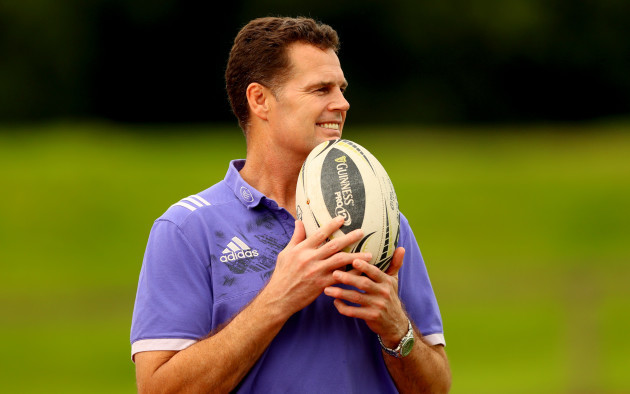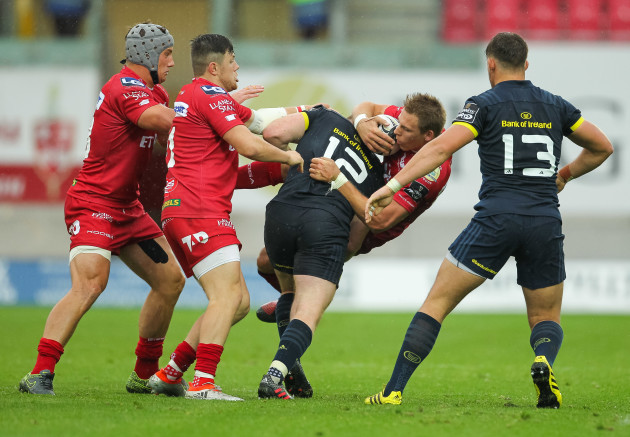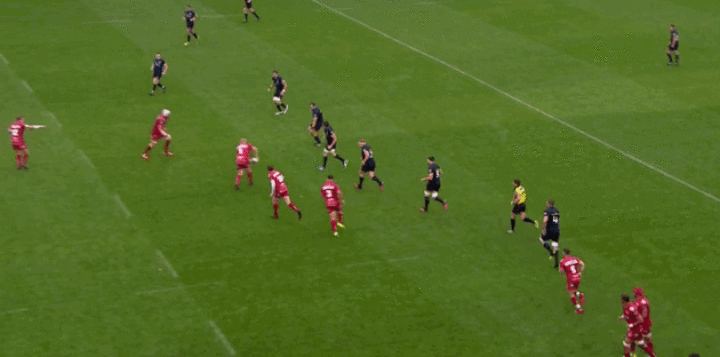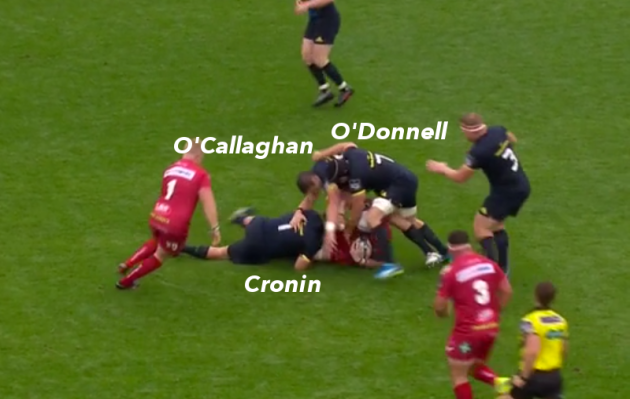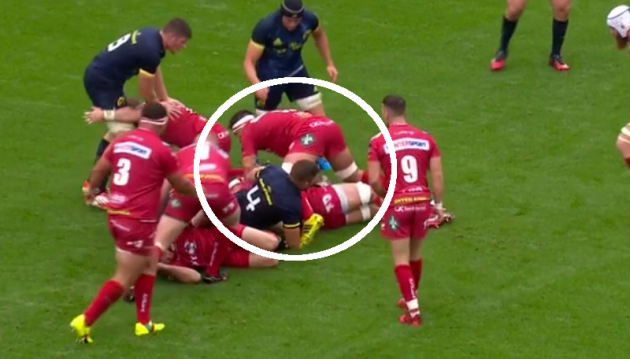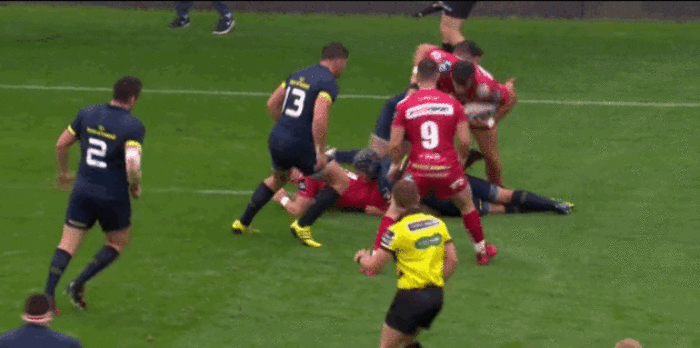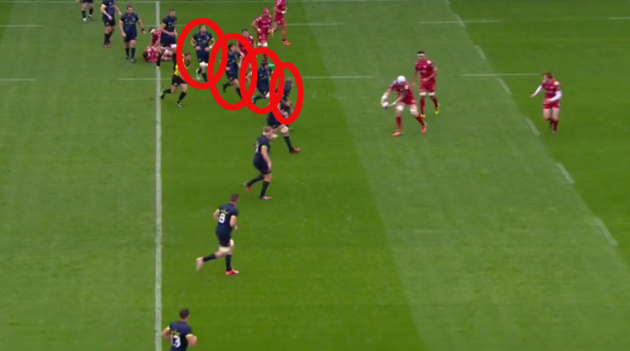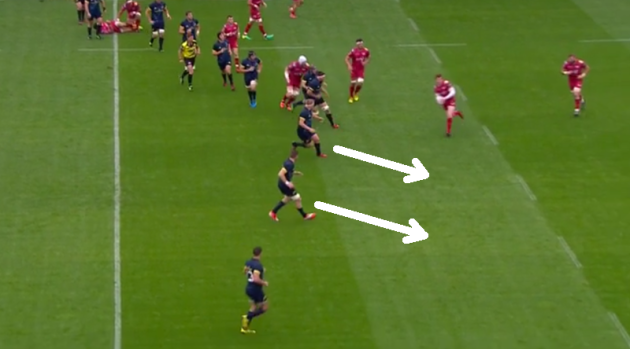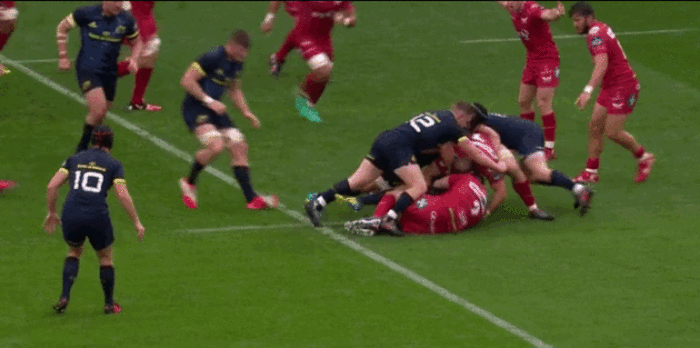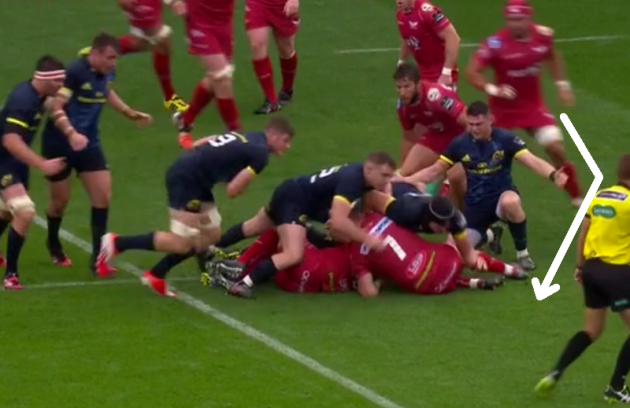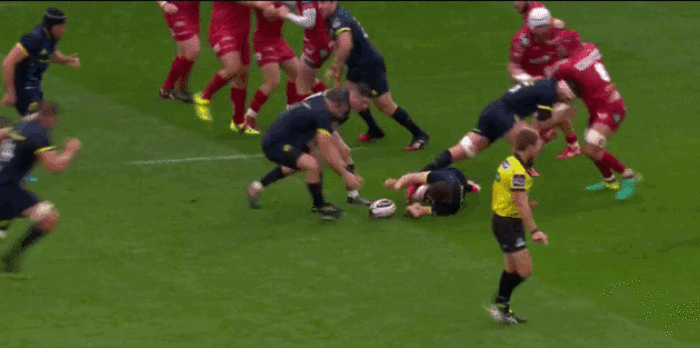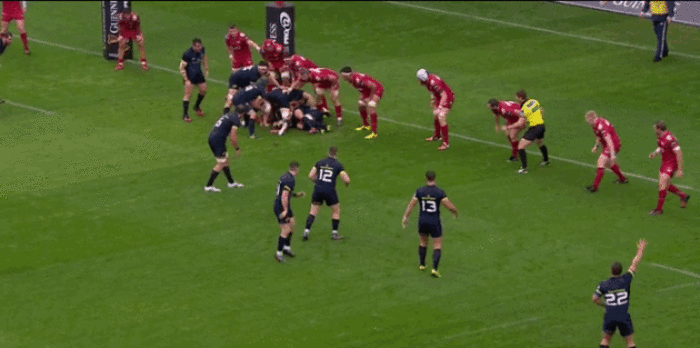“NOTHING GOES AWAY from the meat and potatoes of the game.
“You have got to be able to win your set-piece well and you’ve got to be able to defend well.
Then the plus bit for England is being able to attack well and that’s the area that takes time because it is more complicated, it is more complex. The reality is we have got to make sure we get the simplicity in our players so that they are able to attack with freedom and express themselves.”
Those were the words of Eddie Jones before his first Six Nations as England coach.
The simplicity of the English play was notable throughout the Grand Slam success, and continued in the June series whitewash of Australia, although there were signs of fresh tweaks down under.
Start at the very start, with the most foundational aspects of the game, and grow from there.
It’s a straightforward and sensible mantra, and one that appears to be shared by Munster’s director of rugby Rassie Erasmus.
The southern province opened their season with a 23-13 win away to the Scarlets in the Guinness Pro12 last weekend, Munster’s first victory in Llanelli since 2011.
There was nothing spectacular about the performance, but Munster’s players applied themselves hungrily to a simple and effective game plan on both sides of the ball.
“There are so many things that we would like to implement and do now, but I feel that as a group we must get some solidness about us and just play a few games with that mindset,” said Erasmus before the season began.
On the evidence of Munster’s first game under the South African, those words have been put into practice on the training ground.
There was clarity and aggression in Munster’s defence, while their brief attacking periods demonstrated directness and a clinical edge. The scrum was promising, although the lineout – having looked sharp in pre-season – was the major negative last weekend.
Clean defence
Defence coach Jacques Nienaber has won over Munster’s players since his arrival from the Springboks set-up, and this first competitive defensive outing was encouraging for the province.
There was a try concession to Gareth Davies due to a lapse of concentration before a quick-tap penalty, but with the Scarlets having had more than 60% of the possession, Nienaber will have been pleased with this start to the campaign.
There was clarity to Munster’s defensive actions, strong decision-making around the rucks, excellent tackle technique, aggressive linespeed and an intent to maintain discipline that did, admittedly, slip on occasions.
Defence is a foundational element of rugby, and tackling is the foundation of defence.
On first viewing, Munster looked good in this area. Tackling can be taken for granted in the professional game but the win over Scarlets suggested that Nienaber has been given plenty of training-ground time to work with his players on the basics.
The example above shows James Cronin targeting Jake Ball’s thighs, when it would be easy to go for a glory hit in the torso area.
Cronin gets a firm wrap of the arms in behind Ball’s knees and ensures he comes to deck swiftly in a position that allows Dave O’Callaghan and Tommy O’Donnell to target the ball.
There is no turnover, but the fine tackle technique allows Munster to slow the Scarlets ball and organise their defensive line. On the very next phase, and under pressure, the Welsh region pass the ball into touch.
Munster didn’t always tackle low, of course, but generally their selection and execution of tackle technique was good.
Clear decisions
The decision-making from Munster around the ruck area was also positive at Parc y Scarlets.
Anthony Foley is renowned as an excellent breakdown and ruck coach and he has returned to a hands-on coaching role in this area this season. The early signs suggest Munster may well benefit from having Foley directly involved in this facet of their preparation.
There were many times against the Scarlets when Munster simply stood off the tackle area and looked to get back into the defensive line – recognition of lost causes is crucial for any defence.
On other occasions, Munster made well-calculated calls to attack the ruck looking to spoil or turnover.
Above, man of the match Tommy O’Donnell provides an excellent example of one of the major themes in this Munster performance: intelligent counter-rucking.
Repeatedly, Munster waited for opportunities to attack Scarlets players in weak ‘guard’ positions over the ball.
Second row Lewis Rawlins is the target on this occasion, as he finds himself over the ball, but not in a stable state at all.
Rawlins is not really on his feet here, rather leaning onto the body of ball carrier of Aaron Shingler underneath him. Most referees are content with this arguably illegal picture in the modern game, but Munster and O’Donnell identify it as an opportunity.
O’Donnell lifts Rawlins’ right leg as he drives in on the counter, totally taking the Scarlets lock out of the equation. As that happens, Shingler’s ball placement is compromised, the ball bobbles to Werner Kruger, who fumbles and allows O’Donnell to follow up and complete the turnover for Munster.
Time and again, Munster hassled and spoiled Scarlets possession in this manner.
Outside centre Dan Goggin is the counter-rucking player in the instance above, hammering Davies away from another weak guard position. A penalty comes Munster’s way as DTH van der Merwe plays the ball on the ground.
With O’Callaghan and O’Donnell the two main players tasked with the duty of attempting to jackal over the ball and look for more traditional turnovers, the breakdown and ruck was an area of the game where Munster showed real clarity.
Aggressive intent
It was well flagged that Nienaber would continue Munster’s search for linespeed in defence this season and that aspect of their game was obvious from the very opening minutes.
The ref mic and sideline mics constantly picked up the chorus of Munster’s “Up! Up! Up!” cries as they looked to race forward and tackle the Scarlets behind the gainline.
Aggressive linespeed is something Munster have strived for in recent seasons, meaning the players are dealing with something that they are used to.
The early signs were promising, although the southern province did find themselves stretched on the outside edges at times last weekend.
Early-season hitches are to be expected, of course, and Munster reacted, communicated and scrambled well when the Scarlets looked to play to width – as they did so often.
We see as much in the clip above, as a series of pass from right to left allow Liam Williams and Steff Evans to charge up the left-hand flank.
There’s clear danger as Evans chips ahead but there’s also a dogged effort from Munster fullback Simon Zebo to track back and win the race to the ball, with Rory Scannell also closing in from an initial position in the left backfield.
The Scarlets did manage to stretch Munster in this manner on several occasions, and Nienaber will be looking to ensure that a sharp Cardiff Blues outfit doesn’t do so as frequently on Friday evening in Cork.
‘Spacing’ is essential for any team that wants to generate good linespeed in defence and we can see that Munster’s is slightly off in this instance.
Width in the defensive line allows defenders to rush forward more comfortably, lining up square with the attackers and racing forward to make contact.
As we can see above, however, Munster don’t quite manage to get ideal width in their defence line.
One pass from Scarlets scrum-half Davies to Ball takes four Munster defenders out of the equation. Of course, solidity is required around the fringes of the ruck but there is very little inside Ball to mark up on for Munster in this instance.
At most, this pass should be accounting for three Munster defenders.
That first Scarlets pass removing four defenders means the Munster players further out the line suddenly have to put the brakes on their linespeed and move into a drift.
Goggin clearly thinks about attempting to finish the job by hammering up and hoping to stop the ball with a big spot tackle, but there’s a major risk in doing so.
He eases off instead, then begins to move backwards and across the pitch to link up with the advancing Darren Sweetnam.
It’s not a disaster scenario for Munster and is well redeemed by Zebo in the end, but Nienaber will almost certainly be stressing the point that early width and consistently good numbering-up can allow those big hits behind the gainline.
Direct attack
Munster’s poorly-functioning lineout and minority share of possession meant we didn’t see long periods of attack from them last weekend.
That said, they struck superbly for tries through Cronin and the impressive Ronan O’Mahony.
As suggested by Erasmus’ words in the pre-season and continuing with the theme of their friendly games, Munster’s attacking tactics were largely direct. Crucially, the tempo of many of those direct passages of attack was very high.
Cronin’s try is the obvious example of Munster’s narrow focus and high tempo, as they attack off an initial maul, with Duncan Williams making a good carry away to the right.
Jack O’Donoghue arrives on the scene rapidly, spots space close to the right edge of the ruck and doesn’t hesitate to pick the ball and drive into that chink in the defence.
That space exists mainly because Williams’ strong carry from the maul has taken Ken Owens and John Barclay – both standing off the maul – out of the game.
In turn, that means that out-half Rhys Patchell is suddenly the defender nearest the Scarlets’ left pillar position and he begins to move in towards the ruck as number eight Josh Macleod races to fold around from the far side – having come from the maul.
It’s simple, clever play from Munster and allows O’Donoghue space to make a positive carry.
Ultra-quick ball is ensured by Billy Holland’s excellent clearout of the ruck, as he instantly removes Macleod from a position over the ball.
This is the kind of action that makes Holland such a favourite of coaches and team-mates, with his selfless and ‘quiet’ work off the ball often proving instrumental in allowing others to shine.
The quick ruck means Cronin can bound forward and scoop the ball, before we see another good decision from a Munster player.
The simple thing to do is simply pick and jam again, but Cronin heeds the clear call of Dave Foley on his right shoulder and releases a short pass to the thundering second row to make big gains.
It’s basic play from Munster but it means they’ve turned quick ruck ball into even quicker, non-contested ball in the blink of an eye. The pace and power at which the forwards come around the corner shows clarity in their attacking intent, with O’Callaghan the next to carry.
The Scarlets attempt to recover, conceding a penalty advantage for being offside, as Holland and John Ryan make subsequent carries. With that advantage being played, Cronin strikes for the try, benefiting from good assisting work by O’Donnell.
The actual grounding of the try is unclear – though confirmed by the TMO – but we’re interested in O’Donnell’s leech onto Cronin to help him over the line.
Naturally, Cronin’s own power is vital but the combined effect of O’Donnell hammering into the contact at the same time ensures real momentum in the carry.
With Cronin and O’Donnell’s combined weight well in excess of 200kg, the 98kg van der Merwe cannot prevent them from gaining the initial momentum, and even as other Scarlets defenders pile in, it takes the Munster pair up to the tryline.
Taking 49 seconds in total from lineout throw to reaching the tryline, it’s a very clinical score from Munster.
Their attacking game aside from these high-tempo passages was mainly limited to simple screen plays, but clearly the intention from Erasmus is to build from a solid and direct foundation.
Set-piece
The major work-on for Munster this week will have be their lineout, which suffered badly in the wet conditions at Parc y Scarlets.
Following a frustrating passage of lineout errors that prevented Munster from launching their attack in the second half, there appeared to be a shift towards more basic movement in the lineout and a focus on throwing to the front.
With the current forecast suggesting rain in Cork on Friday evening, Anthony Foley – also in charge of Munster’s lineout this season – will be focused on ensuring the mistakes are far less frequent.
At scrum time, there was further encouragement for Munster as John Ryan and James Cronin performed well and even earned penalties from Dylan Evans and South Africa international Kruger.
As with much of the Munster performance, there was cohesion in the scrummaging performance from the province’s pack, and it’s another aspect they will look to drive forward against Cardiff this weekend.
The performance against the Scarlets was certainly far from perfect, but the earliest signs under Erasmus suggest Munster fans’ optimism is not misplaced.
The42 is on Snapchat! Tap the button below on your phone to add!
